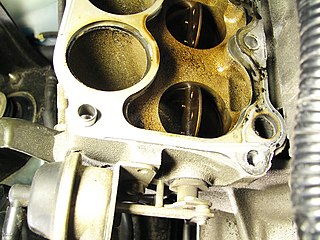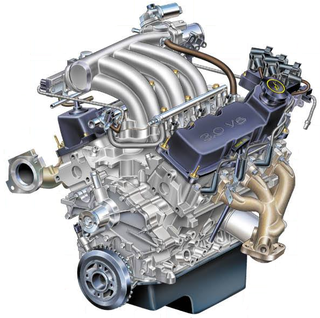
The Ford 335 engine family was a group of engines built by the Ford Motor Company between 1969 and 1982. The "335" designation reflected Ford management's decision to produce an engine of that size with room for expansion during its development. This engine family began production in late 1969 with a 351 cu in (5.8 L) engine, commonly called the 351C. It later expanded to include a 400 cu in (6.6 L) engine which used a taller version of the engine block, commonly referred to as a tall deck engine block, a 351 cu in (5.8 L) tall deck variant, called the 351M, and a 302 cu in (4.9 L) engine which was exclusive to Australia.

In internal combustion engines, a variable-length intake manifold (VLIM),variable intake manifold (VIM), or variable intake system (VIS) is an automobile internal combustion engine manifold technology. As the name implies, VLIM/VIM/VIS can vary the length of the intake tract in order to optimise power and torque across the range of engine speed operation, as well as to help provide better fuel efficiency. This effect is often achieved by having two separate intake ports, each controlled by a valve, that open two different manifolds – one with a short path that operates at full engine load, and another with a significantly longer path that operates at lower load. The first patent issued for a variable length intake manifold was published in 1958, US Patent US2835235 by Daimler Benz AG.

The LA engines are a family of pushrod OHV small-block 90° V-configured gasoline engines built by Chrysler Corporation. They were factory-installed in passenger vehicles, trucks and vans, commercial vehicles, marine and industrial applications from 1964 through 2003. Their combustion chambers are wedge-shaped, rather than polyspherical, as in the predecessor A engine, or hemispherical in the Hemi. LA engines have the same 4.46 in (113 mm) bore spacing as the A engines.

The Ford Modular engine is Ford Motor Company's overhead camshaft (OHC) V8 and V10 gasoline-powered small block engine family. Introduced in 1990, the engine family received its “modular” designation by Ford for its new approach to the setup of tooling and casting stations in the Windsor and Romeo engine manufacturing plants.

The General Motors LS-based small-block engines are a family of V8 and V6 engines designed and manufactured by American automotive company General Motors. First introduced in 1997, the family is a continuation of the earlier first- and second-generation Chevrolet small-block engine, of which over 100 million have been produced altogether, and is also considered to be one of the most popular V8 engines ever. Spanning three generations, a new, sixth generation is expected to enter production soon. Various small-block V8s were and still are available as crate engines.

The Jaguar AJ-8 is a compact DOHC V8 piston engine used in many Jaguar vehicles. It was the fourth new engine type in the history of the company. It was an in house design with work beginning before Ford's purchase of the company. In 1997 it replaced both designs previously available on Jaguar cars: the straight-6 Jaguar AJ6 engine, and the Jaguar V12 engine. It remained the only engine type available on Jaguar until 1999 with the launch of the S-Type, when the Jaguar AJ-V6 engine was added to the list. The AJ-V8 is available in displacements ranging from 3.2L to 5.0L, and a supercharged version is also produced. Ford Motor Company also used this engine in other cars, including the Lincoln LS and the 2002–2005 Ford Thunderbird, as well as in several Land Rovers, and the Aston Martin V8 Vantage.
The Jaguar AJ-V6 engine is a piston engine based on the Ford Duratec V6 engine. The Duratec V6 was originally a Porsche design, purchased by the Ford Motor Company with Cosworth finishing the engineering to suit Ford's needs. One notable addition is the use of variable valve timing, a feature also shared with Mazda's version of the engine. It is available in 2.1 L (2,099 cc), 2.5 L (2,495 cc) and 3.0 L (2,967 cc) displacements.

The Ford Vulcan is a 3.0 L V6 engine designed and built by the Ford Motor Company. It debuted in 1986 in the newly launched Ford Taurus. Ford went on to install the Vulcan V6 in a variety of car, van, and pickup truck models until the 2008 model year, after which production stopped.

The Essex V6 is a 90° V6 engine family built by the Ford Motor Company at the Essex Engine Plant in Windsor, Ontario, Canada. This engine is unrelated to Ford's British Essex V6. Introduced in 1982, versions of the Essex V6 engine family were used in subcompact through to large cars, vans, minivans, and some pickup trucks. The Essex V6 was last used in the 2008 regular-cab F-150, after which it was succeeded by a version of the Ford Cyclone engine. An industrial version of the engine was available until 2015.

The VK engine is a V8 piston engine from Nissan. It is an aluminum DOHC 4-valve design.
The VE engine is a 3.0 L (2,960 cc) piston V6 engine from Nissan. It is based on the Nissan VG engine and was only used for the 1992, 1993, and 1994 model years. This engine has an iron block, aluminum cylinder heads with 4 valves per cylinder and dual overhead camshafts, variable valve timing on the intake camshafts, coil-on-plug ignition, and an available variable intake manifold. Additionally, the engine has a 10.0:1 compression ratio, a cylinder bore of 87.0 mm, and a piston stroke of 83.0 mm.

The Ford SHO V6 is a family of DOHC V6 engines fitted to the Ford Taurus SHO from 1989 to 1995. The designation SHO denotes Super High Output.

In automotive engineering, an inlet manifold or intake manifold is the part of an engine that supplies the fuel/air mixture to the cylinders. The word manifold comes from the Old English word manigfeald and refers to the multiplying of one (pipe) into many.

The Ford Sigma is a small straight-4 automobile engine introduced in 1995 by Ford Motor Company. Its first evolution was sold as the Zetec-S, then Zetec-SE and finally, in later years, renamed Duratec. The last upgrade of the engine is named Duratec Ti-VCT. Conceived for Ford's smaller models, the motor was intended to replace the older HCS and smaller capacity CVH units.

The Ford Taurus SHO is the high-performance variant of the Ford Taurus. Originally intended as a limited-production model, the SHO would be produced for the first three generations of the model line, from the 1989 to the 1999 model years. After an 11-year hiatus, the model was revived for 2010, continuing through the 2019 discontinuation of the Taurus model line.

The Cyclone engine, also branded Duratec, is Ford Motor Company's latest DOHC family of gasoline V6 engines introduced in 2006. The Cyclone succeeds Ford's previous V6 engine families, including the Canadian built Ford Essex engine introduced in 1981, the Ford Vulcan engine introduced in 1985, the original Duratec V6 introduced in 1993, and the Ford Cologne V6 engine, whose design dates back to 1962. The first version of the Cyclone engine, a 3.5 L V6, appeared in the 2007 Ford Edge and the Lincoln-badged luxury variant, the Lincoln MKX, as well as the Lincoln MKZ. Mazda badges its versions of the Cyclone MZI as it did with its versions of the Duratec V6.

The Ford Duratec V6, is an aluminum DOHC V6 engine with a 60° bank angle introduced in 1993 with the Ford Mondeo. The primary engineering input came from Porsche, who was developing a similar V6 before selling the engineering to Ford, and Cosworth, who helped with cylinder head manufacturing. The Jaguar AJ-V6 engine is similar but adds variable valve timing.

The Chevrolet 90° V6 family of V6 engines began in 1978 with the Chevrolet 200 cu in (3.3 L) as the base engine for the all new 1978 Chevrolet Malibu. The original engine family was phased out in early 2014, with its final use as the 4.3 L (262 cu in) V6 engine used in Chevrolet and GMC trucks and vans. Its phaseout marks the end of an era of Chevrolet small-block engine designs dating back to the 1955 model year. A new Generation V 4.3 L (262 cu in) V6 variant entered production in late 2013, based on the LT1 small block V8 and first used in the 2014 Chevrolet Silverado 1500.

Ford Motor Company used the Zetec name on a variety of inline 4-cylinder automobile engines. It was coined to replace "Zeta" on a range of 1.6 L to 2.0 L multi-valve engines introduced in 1991 because Ford was threatened with legal action by Lancia who owned the Zeta trademark. The company used the name widely in European advertising and later introduced it to the North American market with the Contour.


















